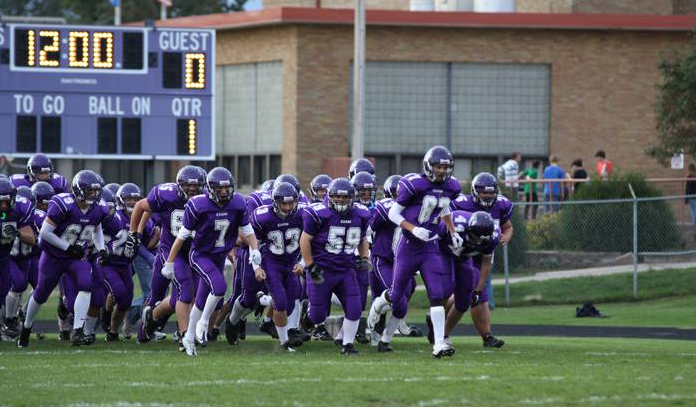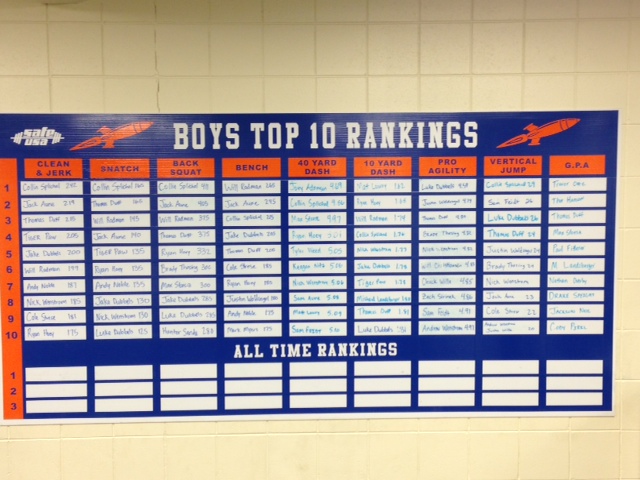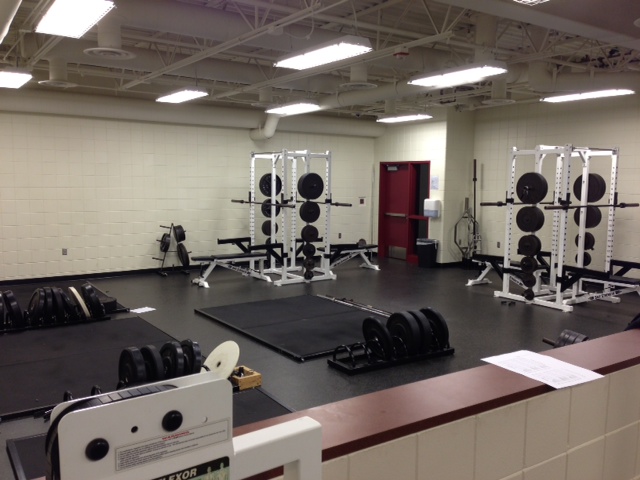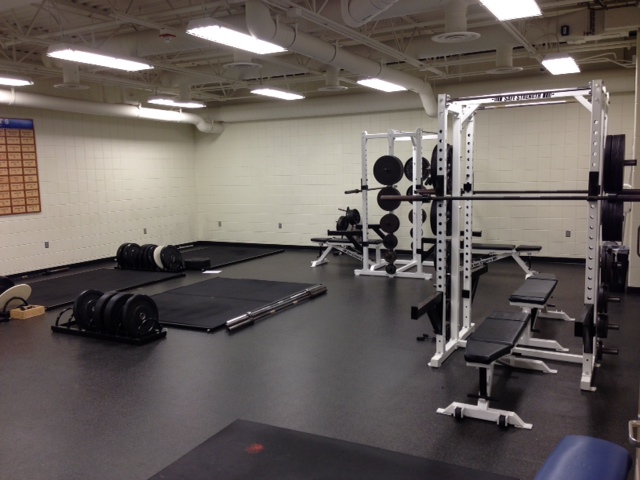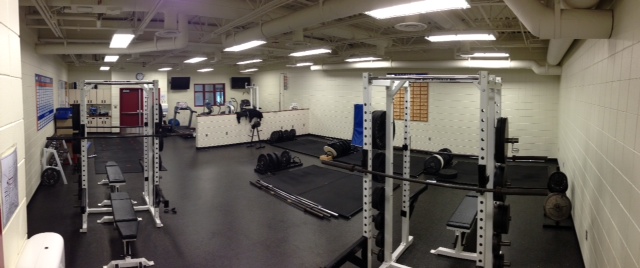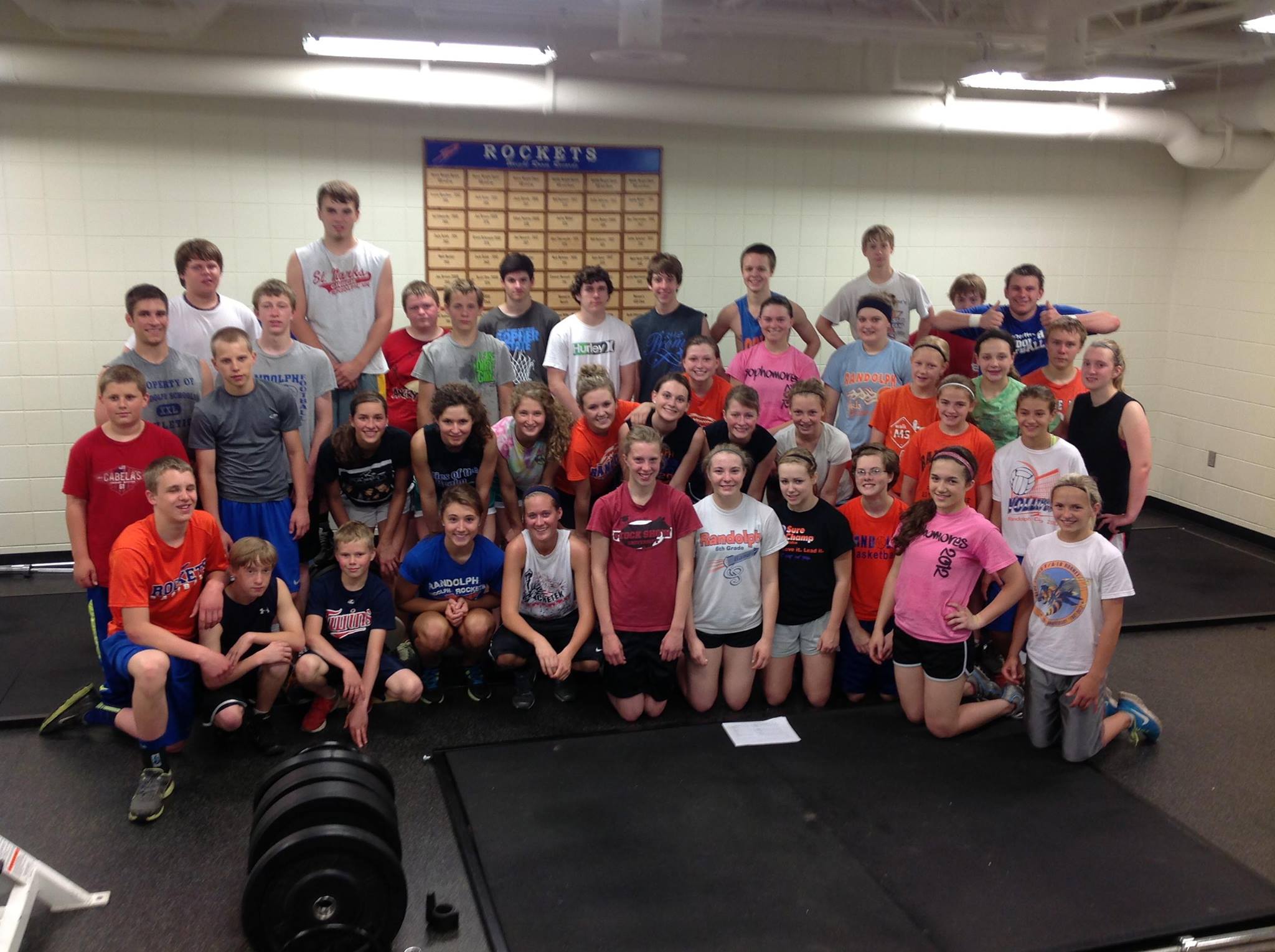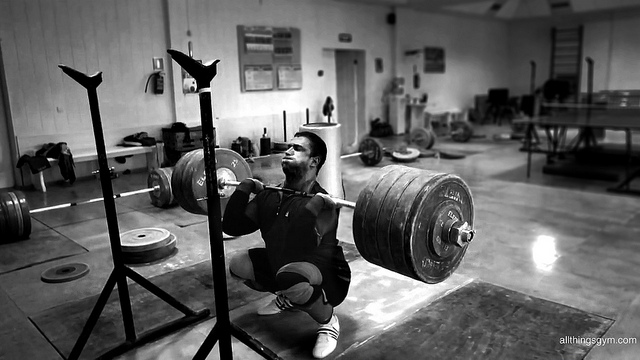The football off-season is here! It’s time to evaluate and to make the changes needed in order to give your team the opportunity to reach their highest potential. Now is the time to look to improve team leadership, your strength program, and learn how to compete frequently!
Author Archives: Strength Pro
Technology In the Weight Room
Strength Pro shows some readily accessible pieces of technology which will assist in developing better athletes and giving instant feedback. This can be used in the weight room, or in nearly any field of play.
Front Squat Progression / Team Mobility
We use aspects of the front squat progression to also look at mobility/flexibility for athletes. This method can be used with a large team to test or “look” for flexibility/mobility issues and will be a great starting point for the front squat. Range of motion/depth is very important while maintaining correct athletic body positioning. Check out the video to see how it’s done:
Strength Training 101 – How to efficiently handle large groups
This will be an ongoing series of articles on how to efficiently handle large groups and still incorporate high skill/high quality movements. Sharing these ideas can help all of us run better strength programs. Our first in this series is Little Falls High School in Little Falls, MN. Nick Abbott is the head strength coach. Little Falls has around 500 students in grades 10-12 and plays 4A 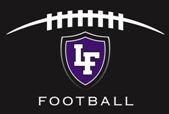 football in the Granite Ridge conference.
football in the Granite Ridge conference.
Strength Pro - Coach Abbott, tell us a little bit about Little Falls High School. “Little Falls is in Section 8AAAA for football. We have roughly 170 students per grade. Our weight room basically consists of 6 squat racks, 6 bench stations, 9 platforms, db’s up to 75lb, kb up to 40lb, 30 steel rods 12lb. 10 female bars, old desktop computer for record keeping, 4 sets pulling boxes for platforms. The room is 95 feet by 40 feet.”
“Jack Marmon and myself are the head coaches. Jack is key in this process because he has been doing this long before I came around, and he is a wealth of knowledge. I run the strength and conditioning during the fall and winter seasons and Jack runs it during the spring season while I’m coaching track. The 2 assistants are different each year depending on who is available. This year we are really lucky to have 2 graduates of Little Falls that now manage gyms when they are not helping us. These guys add a lot to our program. All four of us work each session. The mornings go by very fast. “
Training times for the summer are as follows. All are Monday, Wednesday, Friday
High School – Grades 9 – 12
- 7:00 – 8:30 am
- 8:30 – 10:00 am
- 2 Groups. Average about 60 to 70 per group.
- 3 days per week.
- 1 hour 30 minutes each.
Middle school – Grades 7 & 8
- 10:00 – 11:00 am
- 1 group. up to 50 kids
- 3 days per week.
- 1 hour each.
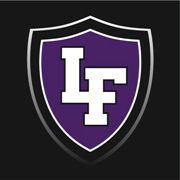 Strength Pro – So tell us how you handle these huge groups of athletes and still do Olympic lifts and quality running. “We spend a lot of our time on the big multi-joint movements. Our kids are soooo busy during the school year and even more so during the summer that we feel we need to teach the big movements with good technique. Before I took the USAW Level 1 course, (Coach Abbott took the USA Weightlifting Level I course about a year ago) we used the squat, bench, power clean as our main movements. After the course we know to take time to teach the clean & jerk and snatch variations, and we use pulling blocks as well. Kids pick up on a lot of athleticism during the process of learning the Olympic lifts. We also find that 12 and 15lb bars are great for learning the movements.
Strength Pro – So tell us how you handle these huge groups of athletes and still do Olympic lifts and quality running. “We spend a lot of our time on the big multi-joint movements. Our kids are soooo busy during the school year and even more so during the summer that we feel we need to teach the big movements with good technique. Before I took the USAW Level 1 course, (Coach Abbott took the USA Weightlifting Level I course about a year ago) we used the squat, bench, power clean as our main movements. After the course we know to take time to teach the clean & jerk and snatch variations, and we use pulling blocks as well. Kids pick up on a lot of athleticism during the process of learning the Olympic lifts. We also find that 12 and 15lb bars are great for learning the movements.
Our motto is:
1. Learn the lift
2. perform consistently
3. add stress.
We use the bench press and military press as our main upper body movements. We know also went from just doing back squat to squatting each day. It may be a back, front, overhead, or goblet squat, but do it everyday and we do it deep. The big thing that we think helps is teaching the kids and expecting them to understand how and why the lifts are done and work. This helps the athletes buy in to the movements as well.
Example: Today we had 70 in the first group and 55 in the second and 48 in the middle school group. There are 2 head coaches and 2 assistant coaches for a total of 4 coaches doing our summer program. 2 coaches stay inside and 2 go outside. Our training structure looks like this:
- We tend to start warm ups 5 minutes early so we get the full 45 minutes to lift and 45 to work on running and movement skills.
- We then take the 30 plus kids in the weight room and make 2 groups.
- I usually take the group that does the Olympic lifts first
- My assistant takes the group that will be doing the squat variation, bench, RDL, or auxiliary lift.
We switch about halfway through so kids get coaching on everything. We try to get 3 lifts and a finisher at the end. A finisher would be farmer carries, kettlebell work, death march, overhead squat competition.
The running group kind of runs the same way. If they have a large group they make two groups:
- one group works on acceleration while
- the other group works on stopping and changing direction or jumping. Once in a while they set up an obstacle course as well.
At the end of a session the kids have been coached in both running and lifting.
Strength Pro - So if I have this correct, you have half of the group inside to weight room, the other half out to run. (in the case of 70 athletes, 35 in and 35 outside)
- 45 minutes weight room/running
- You take ½ of the weight room guys( about 17) and teach Olympic lifts and their variations
- Your assistant takes the other half( about 17) and works squats, presses, etc
- midway through the 45 minute session, you and your assistant coach switch groups and repeat the routine.
- The running group outside does basically the same thing, breaking the group in half and switching half way through the 45 minute segment.
- When the 45 minute strength group is finished, they go outside to run and the outside running group comes in and you just repeat the above.
- Your 70 athlete group really only ends up to be about 17 athletes per coach per segment. Pretty nice sized group!
- With your 6 benches, 6 squat racks and 9 platforms, you have 21 work stations. With approximately 35 athletes in the weight room at once, you have about 2 kids per workstation. That is very efficient use of time. Kids are getting a lot of worksets in.
Oly Lifts group: Other lifts group: Running group 1: Running group 2:
22 minutes 22 minutes 22 minutes 22 minutes
17 athletes 17 athletes 17 athletes 17 athletes
9 platforms (2 per) 6 racks & 6 benches (<2 per)
- At 22 minutes, switch weight room groups & running groups. At the completion of the first 45 minutes, switch outside athletes inside and inside athletes go outside.
Looks like a very nice program functioning at Little Falls. If you have more questions, please contact myself, Scott Safe at scottsafe@footballpower.net or Nicholas Abbott atnabbott@lfalls.k12.mn.us
Work In Progress
I’ve been a strength coach, weight equipment entrepreneur and speaker for 30 years now, and I consistently get told by high school coaches, “I can never have a strength program like yours”. Well, the following story is about a real time “work in progress” at little Randolph High School, located in Minnesota, and football/strength coach Aaron Soule. Randolph has a town population of 436 and graduates around 40 kids per year. They play 9 man football in the Southern Confederacy Conference, and won 1 football game last year. Aaron’s story is interesting as he is in the middle of building the Randolph program. He lays out the steps he’s taken in developing this program, and the development is ongoing. Some interesting and unique points in his program is that he insisted that he be the Head Strength Coach and with input from the other coaches in the school he developed the only workout that would be used by the students. Aaron refused to do it any other way. He also picked 6:15 am on M,W,F for the times. Many thought that may not be a great time, but the numbers show otherwise. He has had tremendous growth in the 1 year he has been in charge. In June of 2013 (1 year after he started the program), he hit 46 athletes training at 6:00 am, which was an all-time record. From the 4-5 kids per morning they were averaging 1 year ago, the growth has been incredible. The following are many of the important points that Aaron has implemented/experienced in the past year:
Steps to building the Randolph High School strength program:
Background
- Randolph was very fortunate to get a referendum passed in 2012, and they were able to get a new weight room with new equipment (4 platforms and 4 multi racks).
- Not a lot of athletic tradition. The football team has 1 winning record since the 1990s. Baseball and softball have been best sports and have been pretty competitive with each winning conference championships recently.
- Aaron wanted control and be able to run whatever program, times, days, etc. Randolph had 5 days a week after school and 3 days a week before school. ”I picked mornings from 6:15-7:30 for a couple of reasons – no conflicts and mental toughness”
- Previous year, the weight room averaged about 4 kids per morning, Aaron’s goal the first year was 10 kids per morning..
- Aaron wanted to be viewed as the weightlifting coach. It was important to present that image to the kids, most importantly Aaron did not want to be viewed as the weightlifting supervisor.
- Aaron wanted to get the gym closed down on Tuesday and Thursday after school to ensure that all kids are on the same workout on the same day.
- Aaron talked to Josh Hofstedt a lot about what they do at Cannon Falls High School, and he was convinced to attempt to get all athletes on same program. Aaron also talked to Cory Johnson (former D1 basketball coach, currently with the Minnesota Timberwolves), Randolph head football/baseball coach, Chris Stanton, and basketball coaches Mike Haase and Tony Linbo, David Flom, Head Basketball Coach at Eden Prairie High School, and Concordia University( MN) VB players (6 time DII Natl Champs). The goal is to create a complete athlete – we can’t focus exclusively on football because of the size of our school.
- Aaron and the rest of the coaches won over the rest of the athletes in the school mostly by listing who was all consulted with. The athletes had to be convinced that this was not just a football only workout.
Building the program
- Randolph bought a new Top 10 Board from Safe-USA. Kids love being recognized and it is updated after workouts.
- There was one meeting prior to the launch of our off-season workout. Aaron and Chris Stanton told the kids that there is only one workout. “We will do this workout.” You can’t bench on every day.” We will go low on our squats” (you’ve got to love this guy!).
- Aaron’s first goal was to make the weight room a place to hang out. If they come into the weight room, Aaron thought maybe he can get them to work.
- Aaron said, “Always be positive. It doesn’t matter what you know or what program you have. If there aren’t any kids, it doesn’t matter.”
- Recruit, recruit, recruit. During Aaron’s prep times at school he would walk down to the cafeteria and talk to the kids about basketball, music, girlfriends, etc but always mention something about the morning weight lifting program.
- It was important for Aaron to find out who Randolph’s high flyers were – the kids that were respected and would commit. Aaron pulled those kids in the corner and taught them how to be leaders. It was important for the kids to be leaders, but how can be a leader if they don’t know what a leader does? There are very few kids with natural leader qualities.
- 6th graders were invited into the weight room. Aaron wasn’t thrilled about allowing them in there that young, but they were eager to come in. They were taught safe and proper lifting form. Aaron figured since our older students were already stuck in their ways; he would try to win the younger kids over before they knew better.
- Celebrated anytime we set a record attendance with a group picture on Facebook. Aaron also emailed the picture to head coaches, the athletic director, the high school principal, and superintendent and encouraged them to thank the kids for coming in that morning.
- Buy treats. Sometimes donuts, but the local convenience store sells bananas for 39 cents a pound. Amazing what a kid would do for a banana. They would show up at 6:15 and work out!
- Hand written notes and mail them to the student athlete and their parents. Thank them for their work. Continued to tell them how they can be leader, resist drugs/alcohol, respect. Very personal. I received many positive comments from parents and players.
- Use an iPad and embrace technology. Take video and put it on Facebook immediately. The kids have contests who can get the most likes. Again kids enjoy being recognized.
- Randolph held a Lift-A-Thon. Aaron wanted the weight lifters to feel like they were a part of a team and not just lifting weights. Aaron wanted to raised money to buy some extra equipment that he felt was important.
- Kids were encouraged to get donations. If an athlete received over $125 in donations they were given a $25 gift card to Buffalo Wild Wings. If they received $10 in donations they received a T-Shirt. The Lift-A-Thon was hyped up around school, Facebook, and Twitter. To celebrate the accomplishments that were being made everyone was encouraged to stop their workout and cheer on their classmates as they were maxing out.
- Weightlifting awards breakfast. We took the last week of school off for a rest week, and that Wednesday we held an invite only breakfast. I put flyers around school with the guest list and put INVITE ONLY in big letters. Qualifications: 50% attendance, participation in the Lift-A-Thon. Named our first ever Ironman. Explained the importance of the Ironman award. Invited a senior athlete to talk about how the weight room has helped him in athletics. Too many times athletes heard the excuse, “I wish I would have lifted and now it is over.” Aaron said, “I didn’t want to hear about athlete’s sob stories anymore. I want to hear from someone who showed up and did it”.
- Our first year went from 4-5 kids per morning the previous year to around 23 kids per morning. Many of our lifters were 8th and 9th graders. We are waiting for the payoff, and will keep working until it comes!
So, if you are looking for a framework to start your program and are sick of excuses why you can’t, here is a great model to work from. I feel Aaron did a great job getting coaches and administration on board, inwardly and outwardly supporting the program. He also has the parents on board, and I think the hand written notes mailed home to Mom & Dad are one of the best ideas I have ever seen. I really liked his insight on starting the students in the 6th grade. What a great foundation he is building with this concept. It will be interesting to measure the results from Aaron’s new program. Truly a “work in progress!” With that in mind, good luck to Aaron and the Randolph Rockets!!! This story is to be continued…
Questions? Please feel free to contact me, Scott Safe at scottsafe@footballpower.net Aaron Soule can be reached at asoule@randolph.k12.mn.us or follow him on Twitter @RandolphFB
New Football Coaching Position – The Football Strength Coach
I know you’ve all heard of strength coaches, but this is different. This is a coach that can make a huge impact on your football program. If you are a high school program, it is an advantage you can have that many others do not. When speaking to coaches, I often say “you don’t need more equipment, you need a real strength coach”. Imagine the dungeon warehouse where Ivan Abadjiev 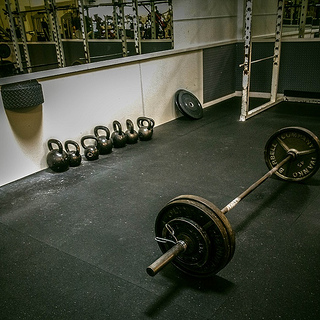 coached the world beating Bulgarian weightlifters in Sophia, Bulgaria. No fancy equipment, no fancy facility, but world record breaking performances. The key was the coach, not the equipment or the facility. The great news is you don’t need thousands of dollars worth of equipment or fancy facilities either. You need platforms, barbells, squat racks and GRAVITY. Even the very low budget school can have the very same training tools that Abadjiev had. So the next thing that coaches ask is, “How do I get started?”
coached the world beating Bulgarian weightlifters in Sophia, Bulgaria. No fancy equipment, no fancy facility, but world record breaking performances. The key was the coach, not the equipment or the facility. The great news is you don’t need thousands of dollars worth of equipment or fancy facilities either. You need platforms, barbells, squat racks and GRAVITY. Even the very low budget school can have the very same training tools that Abadjiev had. So the next thing that coaches ask is, “How do I get started?”
It is key to get the right person from the start. First and foremost they are a coach that understands your football program and will buy in and want to be a part of it. That is why I look at this position as a football coaching position. Many times the football coach and the strength coach do not see eye to eye, and it usually results in a bad environment for coaches and athletes. This position coach must be on board as the “Football Strength Coach”. If this coach does not buy in, he must be replaced, just like any other coach on your staff.
Once you have found the right person for the job, then you must develop the right strength program. Remember that football is an explosive, violent, emotional game. It is my opinion that your strength program should mimic those things. There are a few basic movements that can really enhance these characteristics.
- Bench Press – For upper body strength, the bench press is a good movement. Although it is not the top of the list as far as importance, it is important and we all need upper body strength.
- Squats – What really develops the strength and explosive power needed for football is squats (front & back) and cleans (snatches and jerks are also great). When I say squats, I mean olympic style squats. That means “sit the hips down between the ankles” squats. Much, much deeper than most programs do, but definitely worth the effort. These develop the entire lower body (quads, hamstrings, glutes, etc.)
- Cleans – As far as cleans, snatches, jerks, they are absolutely a must to develop explosiveness. Think of it like this. On a squat or a deadlift, you are decelerating and stopping at the triple extension of the ankle, knee, hip. Very unlike running, jumping, hitting, etc. On a clean, snatch or jerk, you are hitting maximum acceleration at the triple extension, just like running, jumping, hitting. The highest power stresses recorded on humans in the triple extension from two feet happen during the second pull of the clean. (by the way, the highest power stresses happen at about 78% of an athlete’s 1 rep max).
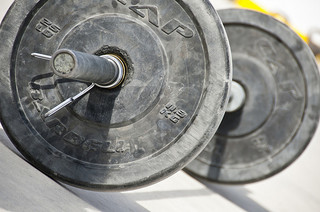 Now for the actual coaching. A huge problem for the new strength coach is that they may have little or no experience teaching squats, cleans, etc. This is a REALLY BIG PROBLEM in America. My advice is quick and relatively painless. Go to www.usaweightlifting.org and sign up for the nearest USA Weightlifting Level 1 Sports Performance coaching course. It is a two day course and they do a great job of teaching these very things. I guarantee if you attend one of these courses you will learn a tremendous amount about how to systematically and correctly teach these movements, and you’ll find they really aren’t that hard to teach after all.
Now for the actual coaching. A huge problem for the new strength coach is that they may have little or no experience teaching squats, cleans, etc. This is a REALLY BIG PROBLEM in America. My advice is quick and relatively painless. Go to www.usaweightlifting.org and sign up for the nearest USA Weightlifting Level 1 Sports Performance coaching course. It is a two day course and they do a great job of teaching these very things. I guarantee if you attend one of these courses you will learn a tremendous amount about how to systematically and correctly teach these movements, and you’ll find they really aren’t that hard to teach after all.
After you have built the foundation of your program and you feel confident in letting them perform a 1 rep max, LET THEM!! Nothing is more fun, exciting, and motivating than a good max day. As a coach, you have to know when to stop them from a safety standpoint, but not letting kids max is really sapping great energy from your program. If your kids are properly coached, injuries are few, but the gains achieved from good, honest competition between teammates is unmatched! Post a “Top 10” list of your main movements on the wall and watch the miracle of competition. A top coach once told me that the “miracle” of Abadjiev in Bulgaria was not his programming or his facility, but it was his competition platform that he had set up in the training hall. His athletes would regularly compete against each other as part of their daily training. No time to relax because some teammate may pass you at any time. The results were world record breaking! You can obtain tremendous results with the same approach. Kind of nice to know that these big fancy new weight rooms (like at Alabama, etc,) can produce no better gains than you can get right in your own high school. Remember, barbells, platforms, squat racks and GRAVITY!! That’s all you need. If you have any questions, please feel free to contact me, Scott Safe at scottsafe@footballpower.net
Squatting for an Attitude
Coaches, in the years that I have been a strength coach, I have seen many freshmen come into fall camp with high hopes of impressing the coaches with their testing, only to find themselves mildly disillusioned and stating, “Back at home I squatted over 500lbs”. The problem is that they were never taught how to squat correctly. So to help you out, I have put together some ideas and suggestions on how to start all of your athletes out in the squat. Before that though, I must first make the following statements:
- Squatting correctly will NOT hurt your knees. Quite the contrary is true. If you are using proper technique, the knee joint as an entirety will become more stable and have a better resistance to injury.
- If you want to develop one tough athlete, have them squat. Very few things are more difficult than having to crawl under a big squat, get deep with it, and come back up. One of my colleges calls it “Feelin’ the Thunder.” Do a few of these and you will know what that means.
- Squatting is a great base to develop many other movements of greater technical difficulty.
Now the following is what we have found to be a great way to start any age or gender on the squat.
Step #1: Body-weight Squat
- We have the person stand with their feet about shoulder width apart, (each person will vary slightly to find their comfort zone)
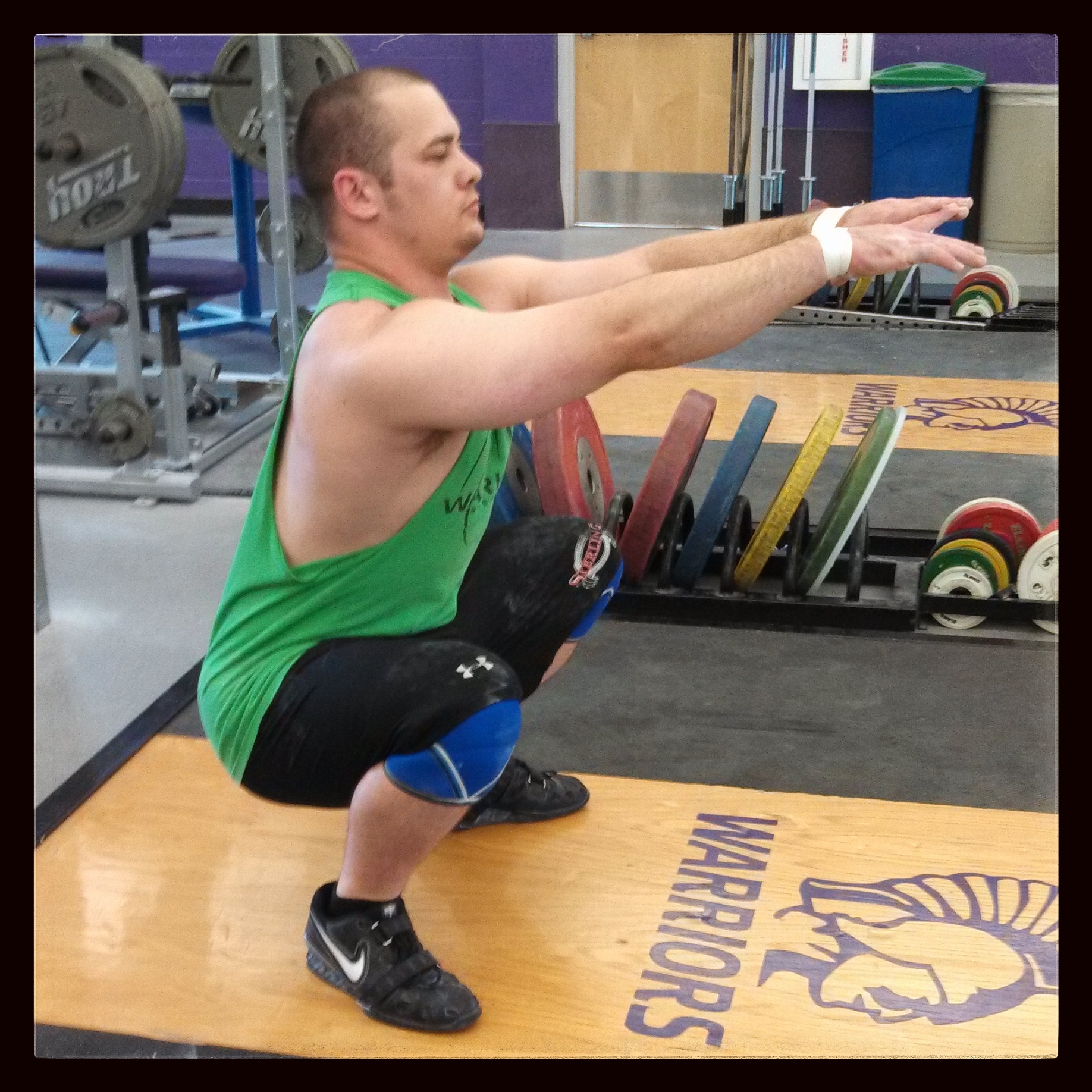 Stand up tall, shoulders back a bit, big chest.
Stand up tall, shoulders back a bit, big chest.- Eyes and chin up at about 45 degrees. Where the eyes go, so do the shoulders and back. By looking up, we want to keep the back in a good position.
- Arms straight out (this is for counter-balance when doing body weight squats)
- Just before descending take a DEEP breath and hold. If you have a belt on push out against the belt. By doing this, thoracic pressure keeps the back in a proper position.
- The first movement that you want to make as you descend, is to sit your hips back, similar to sitting into a chair. Too many people, especially beginners, tend to have their knees to travel forward. This puts the weight on the toes bringing the heels off the ground. It also causes undo pressure on the knees. Again hips back weight on your heels.
- At the bottom, keep chest high and get deep. And I mean get DEEP! Beyond what most of you call parallel at the thighs. I mean butt to the floor deep. My rationale is that you want the athlete to be strong through the entire range of motion. I know many of you say that when you jump or come out of your stance you don’t get that deep, but on any field of play you find yourself in awkward positions. This is when many injuries occur. Let’s give the athletes the opportunity to be strong in any situation.
- As you come up, keep your eyes and chest up, and exhale your air when you are about ¾ of the way up.
You have now completed one squat, congratulations! From here there should be many more to come. Once you have spent a few days, or even weeks on getting the athlete to be able to squat with GREAT TECHNIQUE using their body weight, it is time to move to the next stage.
Step #2: Front Squats
The reason I like front squats over going directly to back squats is that you are able to place your athlete into a better technical position. When starting on the front squat one of the highest priorities is hand placement. It is crucial that you have your athletes use a CLEAN GRIP. Yes, I know that at first this may be a bit difficult and your wrist may be a bit sore, but deal with it. Most athletic 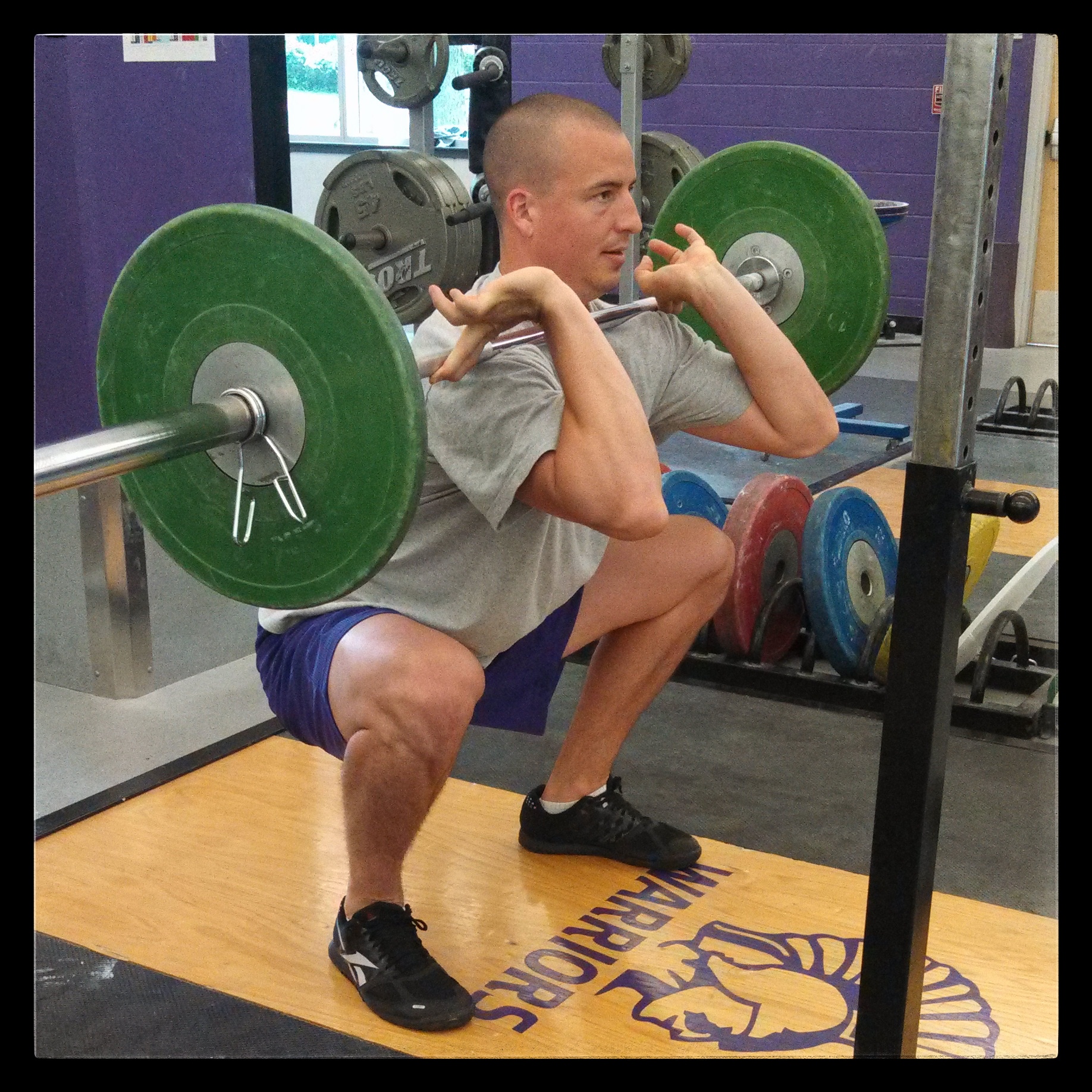 endeavors have some kind of difficulty to them. This is one of those things. With a clean grip the back must maintain a straighter position or the bar will be dropped.
endeavors have some kind of difficulty to them. This is one of those things. With a clean grip the back must maintain a straighter position or the bar will be dropped.
A couple hints on how to do the clean grip correctly. Open the hand so that there are just a few fingers on the bar, rather than gripping it tight. The bar must be supported with the front deltoids, NOT by your hands. The hands should therefore be placed just outside the delts, wider than shoulder width, and not directly in line with the front deltoids. The athlete should also focus on keeping their elbows high, pointing them straight ahead and not dropping them down by their side. Now after several weeks of mastering these first steps in front squatting, only then do I move to the back squat. The transfer from a front to a back squat is easy now. A “high bar position” for the back squat seems to work out best. A few clean-up items:
- Regardless of what you read online or in some magazines, please do not do your athletes the injustice of having them squat to a box or any other range limiting item. Let them develop strength and confidence through the entire range of motion.
- Do not let anyone convince you that a towel or a piece of plastic is needed to hold the bar in place on their backs. In a high bar position the bar should be placed on the rear deltoids NOT on the cervical vertebra.
Lastly, your athletes will thank you in the end because you have properly prepared them to improve in all mental and physical aspects as an athlete. As coaches you will enjoy an athlete who is stronger, quicker, more explosive, and mentally tougher than his/her opponents and aint that a nice thing!
– Jeff Reinardy, StrengthPro.net
